Shell, WYOMING – Nearly every day for the past few weeks, a team of instructors, students, and volunteers have made the slow journey out into the vast, seemingly endless Wyoming prairie just north of the little town of Shell, WY. Their convoy of 4-wheel drive vehicles climb steep, dusty hills and traverse deep gullies, following a long, dusty trail that does not appear on any map. Over the course of three weeks, the team has worked beneath the unforgiving Wyoming sun in search of dinosaur bones.
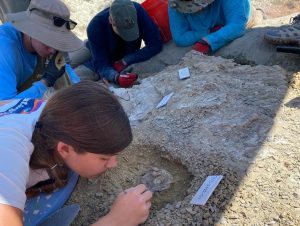
This year, the 13-person group, led by Virginia Museum of Natural History (VMNH) Research Associate Dr. Brooke Haiar (professor and chairman of environmental sciences and sustainability at the University of Lynchburg), included VMNH intern Mason McCabe, a group of students from the University of Lynchburg and the College of William & Mary, as well as other volunteers. The digs are a partnership between VMNH and the university, allowing students the opportunity to participate in something that few people will ever do in their lifetimes: sweeping, hammering, a picking away layers of sand, dirt, and rock to uncover the bones of ancient creatures that, in some cases, are sitting just beneath the surface.
VMNH Director Dr. Joe Keiper said the Code of Virginia states that VMNH “is to establish an efficient network of collaboration between universities and the museum. Essentially, we became the hub and spoke of a collaborative system within the
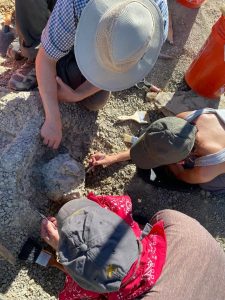
Commonwealth. That was one of the reasons the museum was even established back in the 1980s. It’s one of our purposes and we’re very fortunate to have relatively-nearby universities that have scientists studying topics that
are very much relevant to our collections.”
“We’ve been working this particular site since 2004,” said Haiar, who has been involved with the digs since she was a graduate student. Now, as a professor, she offers the trip as a summer class for university students. “We had been working a site about 5-miles north for about a decade,” when two women approached the group
(which at the time was just museum staff and graduate students) and said they knew where some fossils could be found.
Haiar, who at the time was a graduate student, recalled her advisor, then-VMNH curator Dr. Nick Fraser, went with the women out into the countryside, “and there were a bunch of dinosaur bones. We’ve been digging there ever since.”
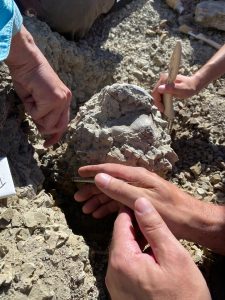
The site, which is on federally-managed land, was named Two Sisters after the two women.
This year, the group is working to begin a new third quarry at the Two Sisters site. Each day (they work seven days a week, weather permitting), they leave their campground at around 7 a.m. to make the 40-minute drive to the site, most of it off-road. Taking up their places around the dig site, all hope for a coveted spot in the shade provided by a pop-up tent, kneeling on pads or laying in the dirt, their faces close to the area they’re working on. Haiar circulates around, surveying the work, guiding the students, and constantly answering the same question: “is this rock or is this bone?”
By 2 or 3 p.m., when temperatures are reaching 100 degrees, the crew packs up for the day, putting away their brushes and dental picks, covering the site, and loading back into their vehicles for a much quieter trip back to camp.
Haiar said the dinosaur they are working on is a sauropod, a group characterized by long necks and tails, small heads, and four thick, heavy legs. A Lynchburg student did some work several years ago to try to narrow down the classification further. “He was able to narrow it down to the (family) Diplodocoidea, which was helpful, but really the only way we’re going to get a tighter definition of what it actually is will be to collect more bones,
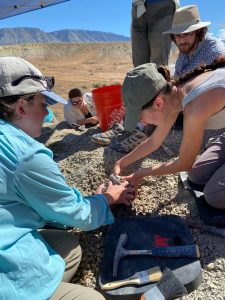
specifically the diagnostic bones in the neck or the head.” Finding the head bones, however, is unlikely as those tend to be incredibly fragile.
The rock in which the team is digging, she said, is late Jurassic, which is about 145 million years old. “This area of the Big Horn Basin is historically well-known for dinosaur fossils of this age.”
The site is near the edge of an ancient sea, known as the Sundance Sea. Yards away from the dig site are fossilized dinosaur footprints, known as a track site. The giant footprints were discovered by a local of nearby Greybull, WY.
“Tracks can only be made by dinosaurs walking in mud,” she said, “but not heavy water, so it had to be close to the edge of the sea. They were able to redraw the line of the Sundance Sea just from that one find.”
Haiar said most of the bones that have been uncovered at the quarries within the Three Sisters site over the years have been in good condition. This summer, though, “we’re opening up this new quarry, so a lot of the stuff is really weathered” as the initial finds are closer to the surface. However, as the quarry grows deeper over several summers of work, she said she is confident the condition of what lies beneath will improve.
Maggie Kicklighter, a rising junior at the University of Lynchburg who was participating in the dig for her second summer, recalled working last year at a different Two Sisters site.
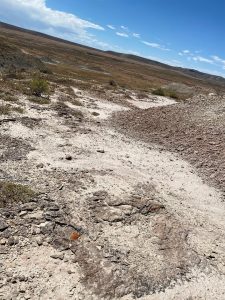
“Under six feet of rock, there are all these beautiful bones,” she said, recalling that one student found a large bone that went straight into rock. Without enough time to completely remove it, they reburied it at the end of that year’s dig. It still lies underground, waiting for another summer.
Until that find, Haiar said, “most of the stuff that had been coming out of that quarry had been small, so it was a question of whether it was a juvenile, whether it was a new genus we haven’t identified yet. This thing (bone) that she found was good-sized. I have hopes that we’ll be able to get down to that” with next year’s dig.
In addition to working on the bones, there are other ways students can contribute to the knowledge of the site. Kicklighter, who is studying geology, said she was working that summer on a stratigraphic column which “details the width of different layers of rock within where you’re digging.”
Kicklighter said she is working on digging a trench up the hillside where the dig is taking place. Eventually, she will create a detailed map of the various types and thicknesses of the rock she uncovers. “That will help us figure out where the dinosaur bones are, and you can use the stratigraphic column to find where else in the area dinosaur bones might be.”
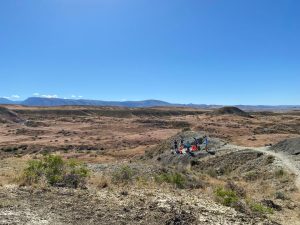
Haiar said that, particularly as they are working on multiple sites which are very close to each other, “having a detailed column like that will help us try to correlate if they are all actually the same layer, of if one is a little bit older.”
McCabe, who serves as dig site manager for the project, said he relishes the opportunity to contribute to paleontological research, particularly as that is the field in which he specializes. Given how sparse specimens are, knowing that “you might be able to bring something back that a future researcher could use really helps the community out and moves research along.”
Haiar said that VMNH is the official repository of the bones discovered at the site. For the six-months leading up to the dig, McCabe said he worked at the museum to sort the finds from, not only the previous year, but from the past 20 years of the digs. “We had such a build-up of it, we weren’t keeping track of where we were putting it, so I made

a list and catalogued what everything was, where it is, and where it will go,” in part to make space for the finds from this year’s as well as future summer digs.
Some of those finds include a discovery Kicklighter made last year—a complete vertebra with the neural spine attached. She said it was the first find of last year’s dig.
This year, McCabe said, the team has discovered some rib bones (gastralia) and are working to remove a set of vertebrae. “We don’t know if they’re part of the neck, if they’re part of the back, or somewhere in between,” he said. Earlier that day, they removed a toe that one student had uncovered a few days prior and, unexpectedly, uncovered some hip bones.
Haiar said that, though she comes into each summer dig with a plan, “what pops up directs how the plan changes.”

McCabe said that there are goals based on “the idea of what we can get done on the worst schedule possible, then stretch goals.” For example, rain may mean the crew loses hours of work as they wait for the ground to dry or, even worse, that they miss a day entirely.
Many of the students on the dig are not eyeing a career in paleontology. In addition to Kicklighter’s focus on geology, this summer’s group included an aspiring dentist and another who wanted to be a doctor. Haiar said she purposely opened up the course to the entire student body, regardless of major.
“Everybody who wants to experience science should get the chance to. You don’t have to have a huge science background to do this work. While they’re here, the skills that they’re learning are applicable to any science and other careers beyond that—how to take field notes, how to do detailed drawings, things like that.”
McCabe, who is pursuing a career in paleontology, said he has learned a lot about the importance of cooperation. He said participating on the dig for the past several years has been his first experience in this type of dig—hot days out in a desert, trying to cooperate with everyone under those extreme circumstances.
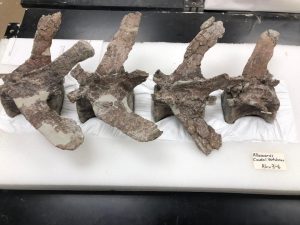
“I think that’s something people don’t realize—a lot of scientists are very insular, they stay in their labs, but in paleo you have to cooperate with people.”
Kicklighter said her experience with the dig has taught her that discoveries in the field are not as cut and dry as what she has experienced in the classroom or the lab.
She discovered a layer of coquina, in which shells are cemented together with sandstone, a remnant of the era of the Sundance Sea, which she had previously missed because “things look totally different in the field.”
Though the dig is in Wyoming, Keiper noted that the project still falls within the VMNH mission.
“As an institution, we interpret Virginia’s natural heritage within a global context. How can we understand what we have here in the Commonwealth if we don’t understand how it relates to the larger world?
“We (in Virginia) have fossils that pre-date the dinosaurs and we have fossils that came after the dinosaurs … so by understanding the evolution of life through the era of the dinosaurs, we can better understand why we have what we have today on the planet Earth and how we can protect it.”
At the end of this summer’s dig, the site in the middle of the Wyoming prairie will be buried once more.
“We bury it as deep as we can and then try to re-contour it so there’s not as much of a cliff,” Haiar said.
“We try to leave it as we found it,” McCabe added.
“Next year, when we come back, we’ll dig it all up again,” said Haiar.



